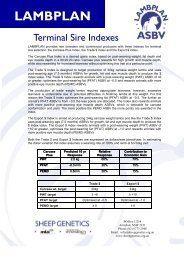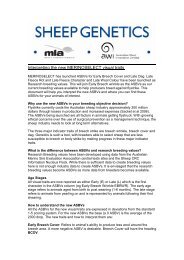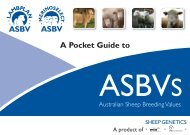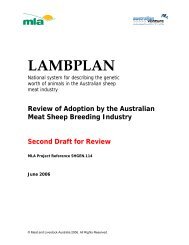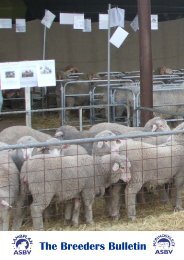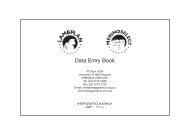The Breeders Bulletin - Sheep Genetics
The Breeders Bulletin - Sheep Genetics
The Breeders Bulletin - Sheep Genetics
Create successful ePaper yourself
Turn your PDF publications into a flip-book with our unique Google optimized e-Paper software.
<strong>The</strong> <strong>Breeders</strong> <strong>Bulletin</strong><br />
Spring 2011<br />
www.sheepgenetics.org.au
<strong>Sheep</strong> <strong>Genetics</strong> Organisational Setup<br />
MLA/AWI<br />
Executive Committee<br />
Dr Rob Banks (MLA)<br />
Dr Alex Ball (MLA)<br />
Ms Jane LittleJohn (AWI)<br />
Mr Geoff Lindon (AWI)<br />
Advisory Committee<br />
Philip Attard (Chair)<br />
Murray Long - 230324<br />
Pendarra White Suffolks, NSW<br />
Mark Mortimer - 601250<br />
Centre Plus Merinos, NSW<br />
Andrew Mosely - 470044<br />
Etiwanda White Dorpers, NSW<br />
Don Pegler - 150022<br />
Oaklea Coopworths, SA<br />
Dale Price - 161886<br />
Majardah Poll Dorsets, SA<br />
Warren Russell - 501704<br />
Melrose Merinos, VIC<br />
Tom Silcock - 504572<br />
<strong>The</strong> Mountain Dam Merinos, VIC<br />
<strong>Sheep</strong> <strong>Genetics</strong><br />
Manager<br />
Sam Gill<br />
Hamish Chandler<br />
Stephen Field<br />
Fiona McLoughlin<br />
David Rubie<br />
Luke Stephen<br />
Nicole Williams<br />
Jaime Carey<br />
Technical Committee<br />
Dr Rob Banks (Chair)<br />
Dr Hans Graser - AGBU<br />
Dr Daniel Brown - AGBU<br />
Dr Andrew Swan - AGBU<br />
Dr Kim Bunter - AGBU<br />
Mr Geoff Lindon - AWI<br />
Dr Jen Smith - CSIRO<br />
Dr Troy Fischer - Industry Rep.<br />
Dr Alex Ball - MLA<br />
Dr Kevin Atkins - NSW I & I<br />
Mr Allan Casey - NSW I & I<br />
Dr Julius Van Der Werf - UNE<br />
Mr Sam Gill - <strong>Sheep</strong> <strong>Genetics</strong><br />
<strong>The</strong> <strong>Sheep</strong> <strong>Genetics</strong> Manager or Staff should always be the<br />
initial contact point for all communication.<br />
<strong>The</strong> <strong>Sheep</strong> <strong>Genetics</strong> Executive is a joint MLA and AWI management group responsible for the operations of <strong>Sheep</strong><br />
<strong>Genetics</strong>.<br />
<strong>The</strong> <strong>Sheep</strong> <strong>Genetics</strong> Advisory Committee has been established to assist in communication and representing to MLA<br />
and AWI the views and requirements of current and potential clients and the wider sheep industry. <strong>The</strong> Committee<br />
has an active role in business planning and annual review of the operational performance of <strong>Sheep</strong> <strong>Genetics</strong>.<br />
<strong>The</strong> <strong>Sheep</strong> <strong>Genetics</strong> Technical Committee comprises representatives from MLA, AWI, AGBU, UNE, NSW DPI,<br />
industry and <strong>Sheep</strong> <strong>Genetics</strong>. <strong>The</strong> role of the <strong>Sheep</strong> <strong>Genetics</strong> Technical Committee is to guide and lead the<br />
development of the <strong>Sheep</strong> <strong>Genetics</strong> analytical engine, OVIS, to continually refine the analysis procedures and<br />
develop new ASBVs to meet industry demand.<br />
Meat & Livestock Australia and Australian Wool Innovation acknowledges the<br />
matching funds provided by the Australian Government to support the research<br />
and development detailed in this publication.<br />
Spring 2011 www.sheepgenetics.org.au 2
Newsletter Contents<br />
Team News 3<br />
Out-and-about 4<br />
Breeder Profile - MPM 4<br />
Research - Meating the Challenge 6<br />
Data Quality 8<br />
Marketing Tips 9<br />
Scoring Visual Traits 10<br />
Genes to Improve Muscle 11<br />
Satisfaction Survey Results 12<br />
Website - Mating Predictor 15<br />
<strong>Sheep</strong> <strong>Genetics</strong> Team News<br />
We would like to welcome Nicole back to<br />
the team, after being away for 4 months<br />
for the birth of her baby girl. Rhali Mia<br />
Williams was born on the 16th May and is<br />
doing well.<br />
Over this period we have been assisted by<br />
Jaime Carey whom many of you will have<br />
talked to on the phone. Jaime has very<br />
capably taken on the project<br />
administrators role and will be missed<br />
when she finishes up mid October for a<br />
short break before the arrival of her baby.<br />
Luke is busily preparing for a trip to New Zealand for the Rugby World Cup, as a<br />
great fan of rugby he is very excited at the prospect. This will probably be his last<br />
holiday before his honeymoon in January.<br />
Sam and Mel are expecting another baby that is due in January, I am sure that<br />
the whole Gill family is eagerly awaiting the arrival of a new family member.<br />
Spring 2011 www.sheepgenetics.org.au 3
Out-and-about<br />
Recently Sam, Hamish and Luke have been busy on the road at a series of “Its Ewe Time”<br />
forums. <strong>The</strong> forums were held in<br />
WA at Katanning, Northam, Dandaragan<br />
NSW at Tamworth and Cooma<br />
QLD at Longreach<br />
VIC at Bairnsdale<br />
SA at Wundinna and Lameroo.<br />
<strong>The</strong> forums were a popular event and a great chance for the team to catch up with current clients<br />
as well as many other producers.<br />
<strong>Sheep</strong>vention at Hamilton and Bendigo <strong>Sheep</strong> and Wool show have both taken place for another<br />
year. <strong>The</strong>se two major events on the sheep producers calendar saw LAMBPLAN and<br />
MERINOSELECT clients achieve good results in the show and sale ring, and our congratulations<br />
go out to all on the results.<br />
Sam has jetted out to the US, to meet with the National <strong>Sheep</strong> Improvement Program (NSIP)<br />
team. <strong>Sheep</strong> <strong>Genetics</strong> has been working with US producers for the last couple of years to<br />
strengthen the industry links between Australia and the US . An initiative that is working well with<br />
the US clients very happy with the service provided by LAMBPLAN.<br />
Breeder Profile: Multi Purpose Merinos Dwain Duxson<br />
<strong>The</strong> Multi Purpose Merino (MPM) group consists of 9 ram<br />
breeders and around 150 commercial breeders spread around<br />
every state of Australia. <strong>The</strong> group was formed in 2000 with the<br />
view to breeding a consistent type of merino that was first and<br />
foremost, a wrinkle free merino.<br />
<strong>The</strong> MPM ewe flock currently totals around 350,000, with a<br />
larger number under the MPM banner in South America.<br />
<strong>Breeders</strong> here in the Eastern part of Australia are building<br />
numbers post drought. Most WA breeders have maintained their<br />
core breeding flocks as they look to come out of drought in<br />
2011.<br />
<strong>The</strong> MPM group places great importance on being involved in<br />
the MERINOSELECT program. It‟s been a great tool to advance<br />
the stock for growth rates, muscle percentages and fat levels.<br />
Some breeders have been involved with MERINOSELECT since<br />
its inception.<br />
<strong>Breeders</strong> are from high rainfall areas, wheat sheep zones or station country and no matter where you go MPM<br />
sheep always look the same. An MPM sheep:<br />
Is a wrinkle free merino<br />
Has been bred by rams and from ewes that have been measured under the MERINOSELECT<br />
program with the focus on growth, muscle and fat levels<br />
Flocks have improved their weaning rates by an average of 20% over the last 5 years (flock<br />
average is around 100% weaning and rising). This compares to the merino average of 77%<br />
Spring 2011 www.sheepgenetics.org.au 4
Grows wool at a faster rate, 60%<br />
of breeders shear earlier than a<br />
traditional 12 month period<br />
(some at 7 to 8 months).<br />
Has an average adult micron of<br />
19, with some flocks finer in the<br />
higher rainfall areas.<br />
<strong>The</strong> majority of breeders sell<br />
their wethers as lambs, which<br />
would have been the minority 5<br />
years ago<br />
Approximately 70% of breeders<br />
do not mules anymore<br />
Have plain rumps but not<br />
necessarily bare breech‟s<br />
Is less susceptible to body strike<br />
due to its non wrinkled skin.<br />
Moojepin Ewe lambs at 11 months of age, both<br />
scanned in lamb with twins<br />
Glendemar MPM Yearling Weights since 1999<br />
Glendemar MPM Yearling Eye Muscle Depths<br />
since 1999<br />
MPM ram breeder‟s are conscious of breeding a sheep that is of a particular type, these breeder„s meet<br />
once a year and consult regularly in regards to any breeding changes so that commercial breeders get<br />
constant genetic upgrading for all the traits that in turn leads to a profitable sheep business, with many<br />
MPM breeders receiving premium prices for their surplus stock in recent times.<br />
<strong>The</strong> MPM group also has a list of sheep classers that help individual breeders get the most out of their<br />
sheep operations, for a list of MPM Ram <strong>Breeders</strong>, MPM <strong>Sheep</strong> Classers and other info go to<br />
www.multipurposemerinos.com.au<br />
Breeder Profile<br />
If you would like to submit a breeder profile<br />
for the upcoming <strong>Breeders</strong> <strong>Bulletin</strong>s please<br />
contact the office.<br />
For more information contact Ben Duxson 03 53592292<br />
or glendemar@aussiebroadband.com.au<br />
Profiles include information such as:<br />
Location<br />
Size of operation<br />
Breeding objectives<br />
How LAMBPLAN/MERINOSELECT<br />
helps you achieve goals.<br />
Spring 2011 www.sheepgenetics.org.au 5
Meating the Challenge Kelly Pearce and David Pethick<br />
Background<br />
Genetic selection for traits important to both<br />
consumers and producers will be the key profit<br />
drivers of productivity and profitability gains for<br />
your sheepmeat enterprise into the future.<br />
Important traits include, lean meat yield, dressing<br />
percentage, tenderness, intramuscular fat and<br />
retail colour. Understanding the inheritance<br />
(heritability) of these traits and their<br />
interrelationships will better enable sheep breeders<br />
to select for improved lamb production into the<br />
future.<br />
Exciting new work by the <strong>Sheep</strong> CRC meat<br />
program has shown that a variety of new traits are<br />
moderately to highly heritable (Table 1). <strong>The</strong>se<br />
include lean meat yield, dressing percentage,<br />
intramuscular fat and shear force (tenderness).<br />
<strong>The</strong>se traits can‟t be visually selected for in a live<br />
animal so prototype Australian <strong>Sheep</strong> Breeding<br />
Values ASBV‟s are being developed to allow for<br />
their selection in a breeding program to improve<br />
the performance of future generations, <strong>The</strong> new<br />
suite of prototype ASBV‟s include lean meat yield,<br />
intramuscular fat and shear force that will become<br />
available from <strong>Sheep</strong> <strong>Genetics</strong>. In addition the INF<br />
flocks are also assisting in increasing the accuracy<br />
of existing ASBVS.<br />
<strong>The</strong> Information Nucleus Flock provides a unique<br />
opportunity for examination of genetic factors<br />
influencing carcass and eating quality, across a<br />
range of environments.<br />
So far- a total 6595 lambs from the <strong>Sheep</strong> CRC<br />
information Nucleus program (INF) have had<br />
carcass and meat quality records following<br />
slaughter. Such as: carcass weight; dressing<br />
percentage; lean meat yield; a range of fresh meat<br />
and retail display colour measurements;<br />
tenderness as measured by shear force; iron, zinc<br />
and omega-3 fatty acid contents of the meat;<br />
This article will give you the background behind<br />
these traits and how they are linked and how the<br />
prototype ASBV‟s will contribute.<br />
1. Nutritional value of lamb<br />
Iron and Zinc<br />
Iron is a strong selling point for red meat,<br />
particularly for women of reproductive age. <strong>The</strong><br />
redness of meat is largely driven by the iron<br />
containing pigment myoglobin within muscle. This<br />
pigment delivers oxygen to the working muscle<br />
cells. Dieticians have described the iron levels<br />
required to underpin a claim of „source‟ or „good<br />
source‟. <strong>The</strong> level of iron in lamb is at, or just<br />
under, a good source claim meaning as an<br />
industry we would not want the values to fall any<br />
lower. A key driver of iron levels is the age of the<br />
lamb and as we increase growth genetics the<br />
potential for reduced iron content is very real. <strong>The</strong><br />
heritability of total muscle iron content is quite low<br />
(Table 1) but the red pigment myoglobin has a<br />
higher genetic component. <strong>The</strong> iron within<br />
myoglobin is the most powerful nutritional source<br />
for humans as it is highly available for digestion.<br />
<strong>The</strong> levels of zinc in lamb muscle are sufficient to<br />
claim lamb as a good source of zinc. However our<br />
initial analyses suggest a weak but significant<br />
unfavorable relationship with the PEMD ASBV<br />
indicating we as an industry should consider<br />
balanced genetic management of zinc levels to<br />
prevent any decrease into the future. Levels of iron<br />
and zinc in the INF lambs were 2.05 mg/100g and<br />
2.31 mg/100g iron and zinc respectively (Iron-<br />
Standard deviation (SD) of 0.44 and range from<br />
0.81-4.51mg/100g and Zinc- SD of 0.39 and range<br />
from 1.18-4.49 mg/100g).<br />
Omega 3<br />
Australians are being encouraged to increase their<br />
intake of long-chain n-3 polyunsaturated omega-3<br />
fatty acids to reduce their risk of chronic diseases.<br />
<strong>The</strong>se fatty acids include eicosapentaenoic acid<br />
(EPA) and docosahexaenoic acid (DHA). <strong>The</strong><br />
average level of EPA plus DHA in lamb meat was<br />
23.5 mg/100 g (SD of 9.32 and range from 4.58-<br />
56.0 mg/100g), which is higher than the level<br />
required to claim that lamb is a „source‟ of omega-<br />
3. Omega 3 levels are heritable, however<br />
differences in the finishing diet also have a<br />
significant effect on omega-3 concentrations in the<br />
muscle.<br />
2. Eating quality<br />
Shear force<br />
Shear force is a laboratory based measure of<br />
tenderness and is based on the kg of force<br />
required to pass a blade through a piece of cooked<br />
lamb. Shear force tenderness of the loin is under<br />
significant genetic control and should be less than<br />
Spring 2011 www.sheepgenetics.org.au 6
about 27 Newtons to be perceived as adequately<br />
tender by the consumer. Average shear force of<br />
the INF lambs 5 days post slaughter was 23.6 N<br />
(SD of 8.2 and range from 10.7-75.6 N). Other<br />
factors such as processing conditions and meat pH<br />
also effect shear force and this trait requires a<br />
whole of supply chain approach to optimally<br />
mange the best outcome (MSA lamb).<br />
Intramuscular fat<br />
Intramuscular fat (IMF) is measured chemically as<br />
the total fat content of the lamb loin. Ideally IMF<br />
should be 4-6% to ensure adequate flavour and<br />
juiciness for a consumer. This level of IMF is low<br />
from a human nutritional perspective and still<br />
allows lean lamb to receive the heart tick (
Data Quality<br />
With most flocks in <strong>Sheep</strong> <strong>Genetics</strong> awaiting the arrival of their Spring drop lambs it is important to also<br />
plan your <strong>Sheep</strong> <strong>Genetics</strong> recording schedule. This is important as recording traits at the incorrect time<br />
can not only see the data excluded from the MERINOSELECT and LAMBPLAN analyses, but may cost<br />
you the breeder the time and expense of having to record the traits again. This document will help outline<br />
the major quality assurance requirements for recording the traits for <strong>Sheep</strong> <strong>Genetics</strong>. Full details on<br />
recording traits can be found in the <strong>Sheep</strong> <strong>Genetics</strong> Quality Assurance manual.<br />
Fleece<br />
<strong>The</strong>re are three major quality assurances required when recording fleece traits for MERINOSELECT &<br />
LAMBPLAN.<br />
1. Animals must be a minimum ten months old when the data is recorded. Animals need to be ten<br />
months old or older as to reduce the maternal differences in fleece characteristics.<br />
2. Animals have to have minimum wool growth for recording fleece quality (Fibre diameter) and fleece<br />
quantity (fleece weight & staple length). <strong>The</strong> minimum time period is to allow animals time to<br />
express genetic differences in wool growth. For recording fleece quality this time period is 5 months,<br />
for fleece quantity this is 6 months.<br />
3. Fibre testing needs to be carried out by an accredited OFFM operator. A list of these operators can<br />
be found on the AWI website.<br />
Carcase<br />
When getting ultrasound carcase measurements on your animals there are three major quality assurance<br />
requirements:<br />
1. <strong>The</strong> carcase scanner must be accredited with <strong>Sheep</strong> <strong>Genetics</strong>. A updated list is available on the<br />
<strong>Sheep</strong> <strong>Genetics</strong> website under the service provider tab.<br />
2. Animals must be a minimum 30 kg live weight. Animals under this weight do not express adequate<br />
genetic differences in fat.<br />
3. <strong>The</strong> average age of the management group must be 100 days old.<br />
Visual traits<br />
Visual traits can be scored by you the breeder on your own property. When scoring breech wrinkle, body<br />
wrinkle, breech cover and dags there are a number of quality assurance guidelines that must be met:<br />
1. Breech wrinkle, breech cover and dags must all be scored in un-mulesed animals. Body wrinkle<br />
may be scored on animals that have been mulesed.<br />
2. Unless scored in the marking cradle. Breech wrinkle, breech cover and body wrinkle must be scored<br />
in animals off shears. This is to get a accurate indication of wrinkle or cover.<br />
3. Dag must be scored prior to crutching after the season break. Dag must be scored in animals<br />
following a worm burden, two months after the season break. <strong>The</strong>re must be adequate variation in<br />
the scores.<br />
Worm Egg counts<br />
When scoring worm egg count the major quality assurance requirement is that the group average must be<br />
280 eggs per gram or higher. If the group average is under 290 the records for the entire group are<br />
excluded from the analysis as there is not enough quality data to give accurate expression of genetics<br />
differences between animal. A good rule of thumb is to measure a portion of the animals first to ensure<br />
that there is an adequate worm burden before measuring the entire group.<br />
A list of the labs currently accredited to record worm egg counts under the service provider tab on the<br />
<strong>Sheep</strong> <strong>Genetics</strong> website.<br />
Spring 2011 www.sheepgenetics.org.au 8
Weights<br />
<strong>The</strong>re are not the major quality assurance guidelines when recording live body weights as the other traits<br />
to measure. However it is important that you consistently check your scales to ensure that they are<br />
accurately measuring. Weights should be recorded to the nearest 0.1 kg.<br />
Summary<br />
Trait Age that can be recorded Requirements<br />
Fleece weight Yearling-Adult 10 months or older, 6 months<br />
wool growth<br />
Fibre tests Yearling-Adult 10 months or older, 5 months<br />
wool growth<br />
Carcase Scanning Early Post weaning-Hoggett Group average age older than<br />
100 days, heavier than 30 kgs<br />
liveweight<br />
Worm Egg Counts Weaning-Hogett Group average to be higher<br />
than 280 eggs per gram<br />
Visual traits (breech cover,<br />
Breech Wrinkle, body wrinkle)<br />
Marking-adult<br />
Animals unmulesed and in<br />
short wool<br />
Dag Marking-Adult In umulesed animals prior to<br />
crutching following the season<br />
break<br />
Table 1. Summary of suitable times and quality assurance procedures for measuring traits in <strong>Sheep</strong><br />
<strong>Genetics</strong>.<br />
If you have any questions regarding the planning of your measurement program please do not hesitate to<br />
contact the office on 02 6773 2948 or info@sheepgenetics.org.au.<br />
MERINOSELECT & LAMBPLAN Branding<br />
Marketing Your Business<br />
With ram sale season quickly approaching it is time to consider how to get<br />
the most out of your advertising and marketing approach.<br />
As members of <strong>Sheep</strong> <strong>Genetics</strong> the use of MERINOSELECT or<br />
LAMBPLAN logos is key in the promotion of your business. <strong>The</strong> use of<br />
these logos signal your commitment to genetic technology that is accurate<br />
and quality assured. It also signals that your business is a part of the worlds<br />
largest and most powerful sheep genetics database.<br />
Displaying your logo in conjunction with MERINOSELECT or LAMBPLAN<br />
logos gives you the strength and brand recognition associated with genetic<br />
excellence.<br />
Below are the two logos that you will be able to implement into your<br />
marketing strategy, promoting your business in alliance with <strong>Sheep</strong><br />
<strong>Genetics</strong>.<br />
For an electronic copy of these files for your own use or to be used by a commercial printing<br />
company please contact the office on 02 6773 2948 or email through your request to<br />
info@sheepgenetics.org.au<br />
Spring 2011 www.sheepgenetics.org.au 9
How to Score Visual Traits for MERINOSELECT<br />
MERINOSELECT have launched ASBVs for Early Breech Cover and Late Dag. <strong>The</strong> aim of this document<br />
is to help you score the traits now included in the MERINOSELECT analysis. <strong>The</strong> scoring system is from<br />
the visual scores guide. To obtain a copy of the visual scores guide please contact the <strong>Sheep</strong> <strong>Genetics</strong><br />
office on 02 6773 2948 or email info@sheepgenetics.org.au<br />
Dag<br />
Dag is on a 1-5 scale and refers to the quantity of faecal material adhering to the wool surrounding the<br />
breech and extending down the hind legs. A score of 1 is a animal that has no dags on the legs or<br />
breech. A score of 5 is a animal that has extensive dags not only remaining in the breech area, but<br />
extending right down the hind legs to the pasterns.<br />
Animals must be a minimum 4 months old. Animals must also be scored prior to crutching and<br />
approximately 2 months after the season break. Animals should only be dag scored if they have<br />
not been mulesed.<br />
Figure 1.1 visual<br />
scores guide for<br />
scoring Dag in sheep<br />
Breech Cover<br />
Breech Cover is scored on a 1-5 scan and refers to the amount of natural bare skin around the perineum<br />
and breech area. A score of 1 refers to an animal that has a natural bare area that extends outwards<br />
around the anus and vulva. An animal that is a score 5 for breech cover has no bare area at all in this<br />
area.<br />
Animals can be either scored in the cradle or in the race to have breech cover scores accepted. Animals<br />
ideally should be scored be at marking in the cradle<br />
Figure 1.2 Visual<br />
scores guides for<br />
scoring breech cover<br />
in lambs<br />
Spring 2011 www.sheepgenetics.org.au 10
Breech Wrinkle<br />
Breech Wrinkle is scored on a 1-5 scan and refers to the degree of wrinkle at the tail set and down the<br />
hind legs. A score of 1 refers to an animal that has no wrinkle. A score 5 animal has extensive wrinkle at<br />
the tail set and extending down the hind legs to the hocks.<br />
Animals can be scored for breech wrinkle in the marking cradle of off shears. Breech wrinkle can only be<br />
scored on unmulesed animals.<br />
Figure 1.3 Visual<br />
scores guide for<br />
scoring breech<br />
wrinkle in lambs<br />
Using Genes to Improve Muscling in <strong>Sheep</strong> Fay Haynes<br />
Increased lean meat yield can be achieved by<br />
selecting meat sheep sires for known genes that<br />
have positive effects on meat traits along with the<br />
traditional breeding selection methods. Researchers<br />
have found a naturally occurring change in a gene<br />
that is known to increase muscle and decrease fat.<br />
<strong>The</strong> gene is myostatin, a suppressor of skeletal<br />
muscle growth and a change in the gene reduces the<br />
production of the myostatin protein resulting in<br />
increased muscling and reduced fat. Variation in<br />
myostatin have been identified in both sheep and<br />
cattle breeds.<br />
Preliminary research carried out <strong>Sheep</strong> CRC PhD<br />
student Fay Haynes from the University of New<br />
England has found that number of copies of altered<br />
myostatin gene influences muscling. <strong>Sheep</strong> with two<br />
copies of the myostatin change have at least a 17%<br />
increase in carcass size and those animals with one<br />
copy have approximately 9% increase, with both<br />
decreasing carcass fat by approximately 12%.<br />
Research on naturally occurring changes to the gene<br />
has been of international and local interest with<br />
studies carried out in Belgium, France, New Zealand,<br />
America and also Australia, and all have found an<br />
increase in skeletal muscle size in animals with a<br />
gene change that reduces myostatin protein.<br />
Following on from Fay‟s preliminary findings, her<br />
early research also recognised that nutrition affects<br />
the growth of lambs with only one copy of the altered<br />
myostatin gene. She found that lambs with a copy of<br />
the gene that were offered unrestricted access to<br />
feed had more muscle growth than those without a<br />
copy, but when offered restricted nutrition the lambs<br />
with one copy performed more poorly than their<br />
normal counterparts. Similar forms of the gene are<br />
also found in beef cattle breeds but the nutritional<br />
effect differs as cattle research colleagues have<br />
found that under unrestricted access to feed cattle<br />
with one copy performed better in converting feed to<br />
muscle growth and under low nutrition or restricted<br />
growth, the animals appear to perform as well if not<br />
better with this naturally occurring myostatin change.<br />
Further research is required to determine the effect of<br />
this gene on development and other performance<br />
traits such as lamb survival, reproduction, growth and<br />
efficiency characteristics. To this end, Fay has bred a<br />
flock of lambs that have none, one or two copies of<br />
the myostatin gene and she is currently assessing<br />
them for live animal traits such as birth, weaning and<br />
post-weaning weights. She will also look at the<br />
effects of the gene on growth, fat development,<br />
carcass and meat quality traits. Fay is pictured with a<br />
“one copy” ewe and her lamb.<br />
Australian sheep meat breeds known to carry this<br />
form of myostatin are the Texel sheep in which over<br />
95% of sheep within the breed are carriers, White<br />
Suffolks with around 10%, Poll Dorset with less than<br />
1% and Charollais sheep. <strong>The</strong> myostatin gene was<br />
originally discovered in 1997 in mice by scientists<br />
investigating the role of different proteins that affect<br />
growth.<br />
Further information:<br />
Fay Haynes<br />
02 67731992 or<br />
fhaynes@une.edu.au<br />
Spring 2011 www.sheepgenetics.org.au 11
<strong>Sheep</strong> <strong>Genetics</strong> Satisfaction Survey 2010<br />
A survey was sent to all current subscribers to <strong>Sheep</strong> <strong>Genetics</strong>. A total of 627 surveys were distributed with<br />
94 or 15% returned. A summary of the results of those returned are as follows and the full report can be<br />
viewed on our website. All comments and suggestions are included in the full report on the web.<br />
General Information and Website<br />
What type of Breeder are you<br />
What is the size of your flock<br />
How often do you visit the <strong>Sheep</strong><br />
<strong>Genetics</strong> website<br />
Do you use the search section of<br />
the website<br />
Do you use the web catalogue to<br />
advertise sale animals<br />
Do you use the web catalogue to<br />
advertise semen sales<br />
Do you use the website as an<br />
information source<br />
Would you like to receive training<br />
via online workshops<br />
Would you like to participate with<br />
other breeders in online forums/<br />
blogs<br />
LAMBPLAN<br />
MERINOSELECT<br />
LAMBPLAN<br />
MERINOSELECT<br />
LAMBPLAN<br />
MERINOSELECT<br />
LAMBPLAN<br />
MERINOSELECT<br />
LAMBPLAN<br />
MERINOSELECT<br />
LAMBPLAN<br />
MERINOSELECT<br />
LAMBPLAN<br />
MERINOSELECT<br />
LAMBPLAN<br />
MERINOSELECT<br />
Terminal Maternal Merino Goat Other<br />
47% 23% 29% 0% 1%<br />
0-50 50-100<br />
100-<br />
300<br />
300-<br />
600<br />
600+<br />
11% 18% 26% 32% 13%<br />
0% 4% 15% 23% 58%<br />
Daily Weekly Monthly Quarterly Never<br />
8% 37% 32% 12% 11%<br />
4% 44% 36% 16% 0%<br />
Yes<br />
No<br />
84% 16%<br />
96% 4%<br />
Yes Maybe No<br />
14% 50% 36%<br />
4% 79% 17%<br />
Yes Maybe No<br />
18% 36% 46%<br />
16% 56% 28%<br />
Yes<br />
No<br />
89% 11%<br />
92% 8%<br />
Yes Maybe No<br />
36% 42% 22%<br />
36% 48% 16%<br />
Yes Maybe No<br />
20% 44% 36%<br />
16% 56% 28%<br />
Spring 2011 www.sheepgenetics.org.au 12
Products & Services<br />
Agree<br />
Neither<br />
Agree or<br />
Disagre<br />
e<br />
Disagree<br />
Staff members can be contacted easily<br />
Requests are dealt with in a timely<br />
manner<br />
<strong>Sheep</strong> <strong>Genetics</strong> reports can be easily<br />
interpreted<br />
ASBVs assist achieving breeding<br />
objectives<br />
ASBVs are an effective marketing tool<br />
ASBVs are used to assist in making<br />
joining decisions<br />
ASBVs are used routinely by my<br />
clients to purchase rams or ewes<br />
Do you find the Elite animal listing<br />
useful<br />
LAMBPLAN 22% 52% 24% 2% 0%<br />
MERINOSELECT 24% 40% 32% 0% 4%<br />
LAMBPLAN 18% 42% 25% 12% 3%<br />
MERINOSELECT 12% 28% 24% 24% 12%<br />
LAMBPLAN 23% 52% 14% 6% 5%<br />
MERINOSELECT 36% 40% 20% 4% 0%<br />
LAMBPLAN 40% 38% 14% 3% 5%<br />
MERINOSELECT 48% 36% 12% 0% 4%<br />
LAMBPLAN 31% 25% 36% 6% 2%<br />
MERINOSELECT 36% 24% 28% 8% 4%<br />
LAMBPLAN 43% 28% 20% 6% 3%<br />
MERINOSELECT 54% 25% 13% 4% 4%<br />
LAMBPLAN 9% 33% 27% 16% 16%<br />
MERINOSELECT 8% 25% 33% 21% 13%<br />
Yes Maybe No<br />
LAMBPLAN 59% 29% 13%<br />
MERINOSELECT 44% 32% 24%<br />
LAMBPLAN (You) 45% 15% 40%<br />
Do you (or your clients) find<br />
accuracies confusing<br />
MERINOSELECT<br />
(You)<br />
LAMBPLAN<br />
(Clients)<br />
MERINOSELECT<br />
(Clients)<br />
30% 17% 52%<br />
83% 17%<br />
100%<br />
Have you had the opportunity to attend<br />
a workshop in the past year<br />
LAMBPLAN 31% 6% 63%<br />
MERINOSELECT 46% 0% 54%<br />
Apart from material supplied by <strong>Sheep</strong> <strong>Genetics</strong>, from where else do you source genetic information<br />
<strong>The</strong>se answers were not prompted.<br />
26% Other <strong>Breeders</strong> 18% Only <strong>Sheep</strong> <strong>Genetics</strong><br />
10% Web 08% <strong>Sheep</strong> CRC<br />
07% MSS 05% Consultants<br />
05% Catalogues<br />
Continued over page...<br />
Spring 2011 www.sheepgenetics.org.au 13
Excellent<br />
<strong>The</strong> next section refers to the publications produced by <strong>Sheep</strong> <strong>Genetics</strong>.<br />
Publications<br />
Poor<br />
Good<br />
Please rate the <strong>Sheep</strong> <strong>Genetics</strong><br />
Breeder‟s <strong>Bulletin</strong><br />
LAMBPLAN 0% 6% 42% 40% 11%<br />
MERINOSELECT 4% 0% 48% 40% 8%<br />
Please rate the <strong>Sheep</strong> <strong>Genetics</strong> Pen<br />
Cards<br />
LAMBPLAN 6% 11% 29% 49% 6%<br />
MERINOSELECT 17% 25% 17% 33% 8%<br />
Please rate the other publications<br />
and marketing material<br />
LAMBPLAN 0% 11% 39% 46% 4%<br />
MERINOSELECT 5% 0% 55% 35% 5%<br />
Is there enough commercial service available to assist with your breeding enterprise<br />
LAMBPLAN MERINOSELECT<br />
Yes 84% 89%<br />
No 16% 11%<br />
Would you like more information on Genomics<br />
LAMBPLAN MERINOSELECT<br />
Yes 80% 81%<br />
No 20% 18%<br />
At what price should the mate selection software be priced<br />
LAMBPLAN MERINOSELECT<br />
$100 39% 22%<br />
$250 39% 44%<br />
$500 23% 33%<br />
$1000 0% 0%<br />
* Only 46% answered this as most seemed confused about the mate selection software.<br />
Spring 2011 www.sheepgenetics.org.au 14
<strong>Sheep</strong> <strong>Genetics</strong> Website A Tool for Information and Marketing<br />
Mating Predictor<br />
If you are a regular visitor to the <strong>Sheep</strong> <strong>Genetics</strong> web site, you may have noticed a new addition to the<br />
search page. <strong>The</strong> Mating Predictor facility has been introduced to help breeders predict the ASBVs for the<br />
progeny that would result from a range of matings between different sires and dams.<br />
<strong>The</strong> link to the Mating Predictor can be found by going to the sheep <strong>Genetics</strong> website<br />
(www.sheepgenetics.org.au) and selecting either the LAMBPLAN or MERINOSELECT Search link. <strong>The</strong><br />
new Mating Predictor can be found on the Search page, with the link located under the Basic Search and<br />
Advanced Search links.<br />
<strong>The</strong> Mating Predictor allows you to enter the ID for up to 50 rams and 50 ewes. <strong>The</strong> ewe IDs can be either<br />
manually entered, or imported in a text or excel file. Once the IDs of the males and females have been<br />
entered, clicking the “Show predicted ASBVs for progeny” button will calculate the mid-parent ASBVs for<br />
each of the possible combinations of matings for the listed rams and ewes. Only breeding values where<br />
the average accuracy of the ram and ewe‟s ASBVs is above the normal accuracy threshold will be<br />
reported.<br />
Please note that the breeding values calculated by the Mating Predictor are indicative values only, based<br />
on what we know from the given pedigree details. <strong>The</strong> actual ASBVs calculated for any progeny from the<br />
same joining would take into account recorded performance for that animal and its relatives. <strong>The</strong><br />
progeny‟s actual ASBVs may therefore vary from the predicted mid-parent values.<br />
All animals with publicly available ASBVs can be used by the Mating Predictor. If you do not publicly list<br />
your animals on the <strong>Sheep</strong> <strong>Genetics</strong> web site, you can still utilise the Mating Predictor through the secure<br />
Members Login area.<br />
Image 1: Example results using one terminal sire and two terminal dams.<br />
Spring 2011 www.sheepgenetics.org.au 15
PO Box U254<br />
UNE ARMIDALE NSW 2351<br />
Phone: 02 6773 2948<br />
Fax: 02 6773 2707<br />
Email: info@sheepgenetics.org.au<br />
Web: www.sheepgenetics.org.au<br />
Published by Meat & Livestock Australia Limited ABN 39 081 678 364 and Australian Wool<br />
Innovation Limited ABN 12 095 165 58, September 2011<br />
ISSN: 1448 790 X<br />
Care is taken to ensure the accuracy of the information contained in this publication. However, MLA<br />
cannot accept responsibility for the accuracy or completeness of the information or opinions<br />
contained in the publication. You should make your own enquiries before making decisions<br />
concerning your interests. You may also contact MLA on 1800 023 100. MLA accepts no liability for<br />
any losses incurred if you rely solely on this publication.<br />
Reproduction in whole or part of this publication is prohibited without prior consent and<br />
acknowledgement of Meat & Livestock Australia or Australian Wool Innovation.<br />
Meat & Livestock Australia acknowledges the matching funds provided by the Australian<br />
Government to support the research and development detailed in this publication.<br />
© Meat & Livestock Australia and Australian Wool Innovation (2011)<br />
Spring 2011 www.sheepgenetics.org.au 16




